
The digital marketing landscape is characterised by intensity and diversity: In the battle for consumers’ attention, brands are spending big on an unprecedented array of platforms.
Marketers’ social media budgets have exploded in recent years, while companies spent an estimated $33 billion on native advertising in 2018. Simultaneously, longstanding techniques show no signs of fading. Search ads remain the largest form of online advertising, accounting for roughly 42 percent of 2018 ad spending. As the opportunities – and obligations – of digital marketing evolve, it’s clear that relevance requires messaging on multiple channels.
Yet, recent research calls companies’ cross-platform efforts into
question. Consumers are increasingly frustrated with digital ads they
deem intrusive, causing many to install ad blockers. Additionally, the
influence of online reviews has swelled in recent years, as shoppers
seek to understand if brands’ advertising claims are credible. Which
digital marketing tactics actually drive consumers’ purchase decisions?
And how can advertising effectively complement customer reviews?
To explore these questions, we surveyed over 2,000 individuals in the
U.K. and U.S., studying how various advertising tactics affect their
buying behaviour. We also analysed the impact of online reviews and
the most powerful aspects of customer feedback. Our results provide a
holistic view of attracting customers online through multiple brand touch
points. To understand which digital marketing channels matter most to
real consumers, keep reading.
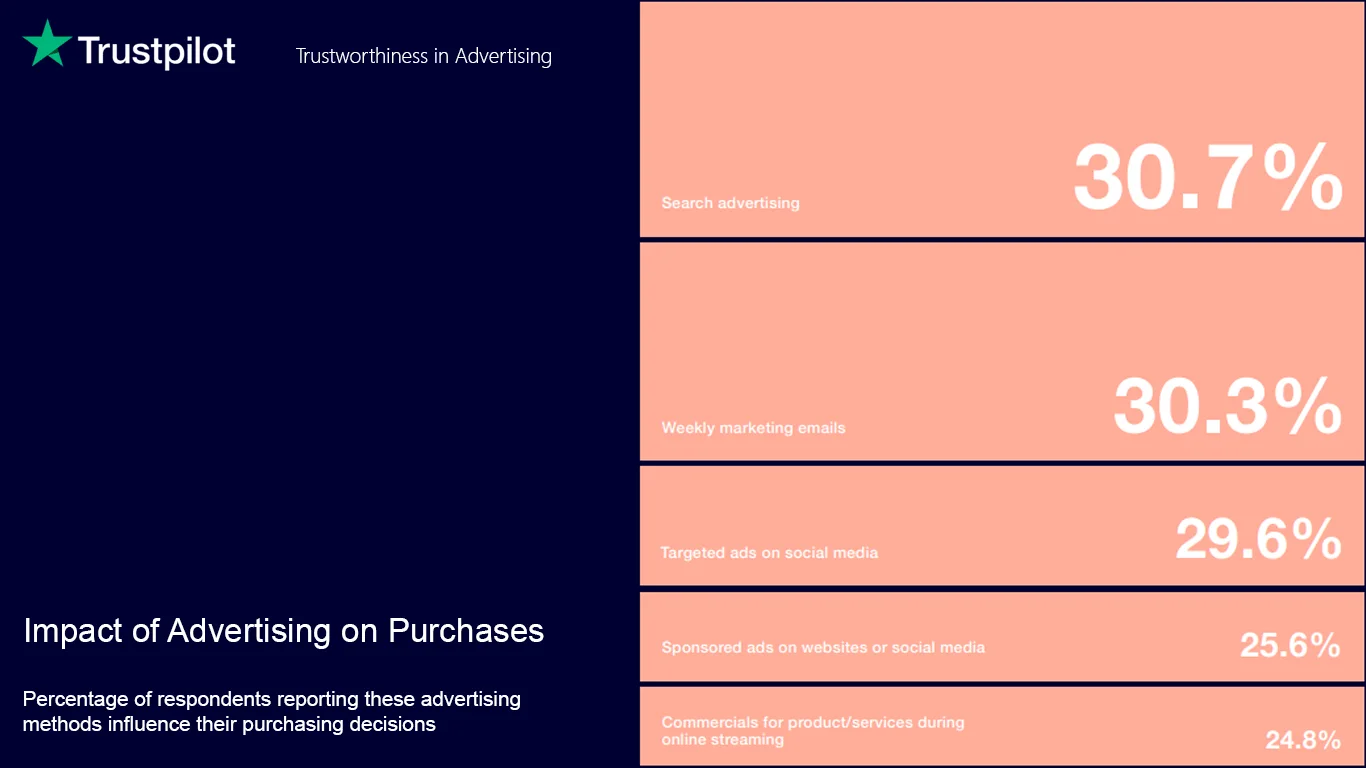
Consumer insights on the effectiveness of different advertising channels
Advertising immunity?
Regardless of the particular platform, most consumers voiced scepticism about the power of digital advertising to affect their own purchase decisions. Indeed, for each advertising platform included in our survey, less than a third of individuals admitted to being influenced by ads of that kind. This finding may support the notion of effective frequency, which
suggests that advertising convinces through cumulative exposure over time. Accordingly, we may find our choices shaped subconsciously, even though we find any single ad unpersuasive.
Still, our data imply that most shoppers are unimpressed by the advertising content they encounter, whether through search engines or social media. Adverts that interrupt online streaming were deemed least influential overall, with merely a quarter of respondents saying such ads informed their buying behaviour. Viewers have registered strong opposition to such adverts in the past: One recent study found that roughly a quarter of Netflix subscribers would drop the service if it began to run ads.
In some cases, women were significantly more likely to admit that certain ads affected their purchase decisions. Roughly 1 in 3 women said targeted social media ads influenced their purchase decisions, and 27 percent said they’d been swayed by sponsored content on websites or social networking platforms. This gender gap might reflect how female-centric categories, such
as the beauty industry, have been revolutionised by social media in recent years. Additionally, women are more likely than men to use social media, therefore increasing the odds they’ll be influenced on such platforms.
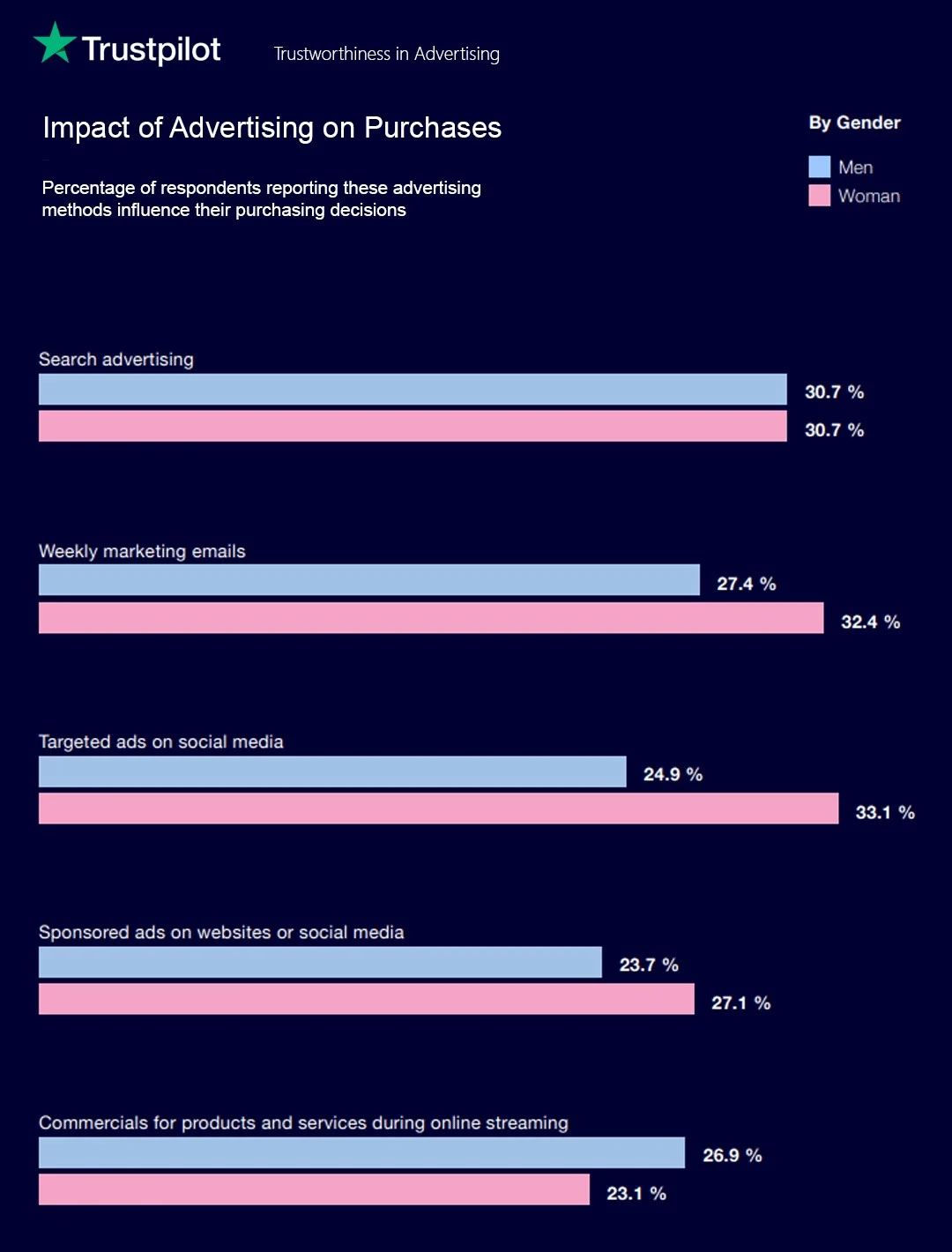
Consumer insights about the influence of ads on purchasing decisions, broken out by gender
Persuasion by nation
Our data suggest that some modes of digital marketing may resonate to a greater extent with audiences in the U.S. than consumers in the U.K. Individuals in both countries were roughly equally likely to say that search ads and weekly marketing emails affected their purchase decisions. Yet,
a greater percentage of Americans reported being influenced by targeted social media ads, and an even larger gap emerged around sponsored content. Adverts on streaming services seemed far more effective for U.S. audiences as well.
If U.K. consumers are less likely to feel influenced by marketing on social media, it’s not for a lack of effort on the part of British brands. Social media advertising is set to reach £4.59 billion by 2020, surpassing the entire U.K. television ad market.
However, the U.K. is a particularly difficult climate for advertisers, whose efforts are viewed with intense suspicion. Indeed, one recent study found that advertising executives were the nation’s least trusted profession overall.
In most regions of the U.K., respondents were most likely to report being influenced by search ads. There were some exceptions to this trend,
however: Scotland, Greater London, and Yorkshire and the Humber were areas particularly receptive to targeted social media ads. In the U.S., the Northeast and South also regarded targeted ads on social media as especially
effective, whereas the West was more inclined toward sponsored content. This finding confirms the complexity of consumer experiences: No single platform can dominate countrywide.

Impact of advertising broken out by US and UK consumers
Trust troubles
Thus far, our results have varied substantially across demographic categories. Yet, one overarching theme holds true: With regard to each kind of digital platform, most consumers regard ads as ineffective in influencing their behaviour. Could these dismissive attitudes reflect a deficit of trust in advertisers’ claims?
Our findings imply that suspicion is widespread: Less than 3 in 10 consumers said they trusted each kind of digital advertising. Targeted ads on social media and sponsored ads on social platforms and websites were viewed with particular skepticism. These data points suggest that consumer trust won’t be won through new trends and technologies. As some marketing experts have recently noted, influencer endorsements can be forced and ineffective in connection with particular products.
Compared to U.K. residents, American respondents were more trusting of advertising platforms overall. Additionally, women tended to trust digital ads of different kinds at higher rates than men. However, even the most credulous demographic categories were largely resistant to advertisers’ claims – a far-reaching trend that researchers have labeled a “consumer trust crisis.” If the vast majority of consumers doubt the veracity of digital advertising, when is it actually effective?
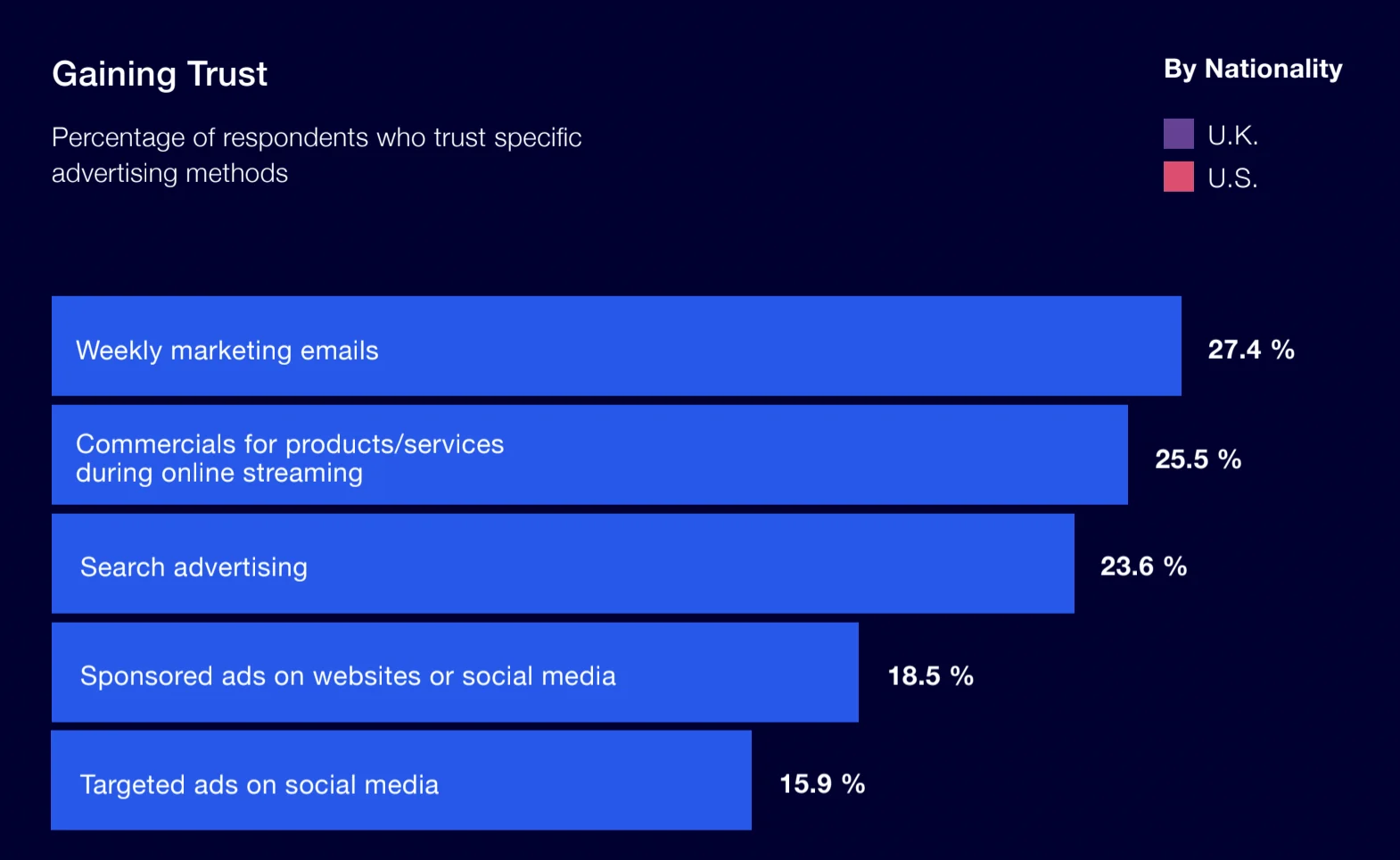
Convincing Content
U.K. and U.S. residents alike valued an attractive price: When asked why they purchased something from an ad, over three-quarters of respondents in each region said they were driven by a good deal. Another top reason – especially among Americans – was that the ad reminded them of a product or service they’d previously considered. Although this dynamic can occur organically, this sort of reminder is often more than mere coincidence. Advertisers often “retarget” consumers who have reviewed their products or services in the past, using tracking pixels to serve up related ads across the internet.
These top two reasons share a central purpose: Their goal is to encourage the completion of a purchase, rather than drive initial awareness of a product or service. Indeed, comparably few individuals said they purchased something after an ad offered more information or attempted to forge an emotional connection. If effective ads capitalise on pre-existing impressions, how do consumers form opinions about the things they eventually buy?
For many individuals, the answer is online reviews. According to one recent study, 84 percent of consumers trust online reviews as much as personal recommendations from people they know – a stark contrast to the widespread
suspicion of advertising discussed above. Yet, if reviews are an essential part of consumer research, what makes authentic customer feedback particularly powerful?
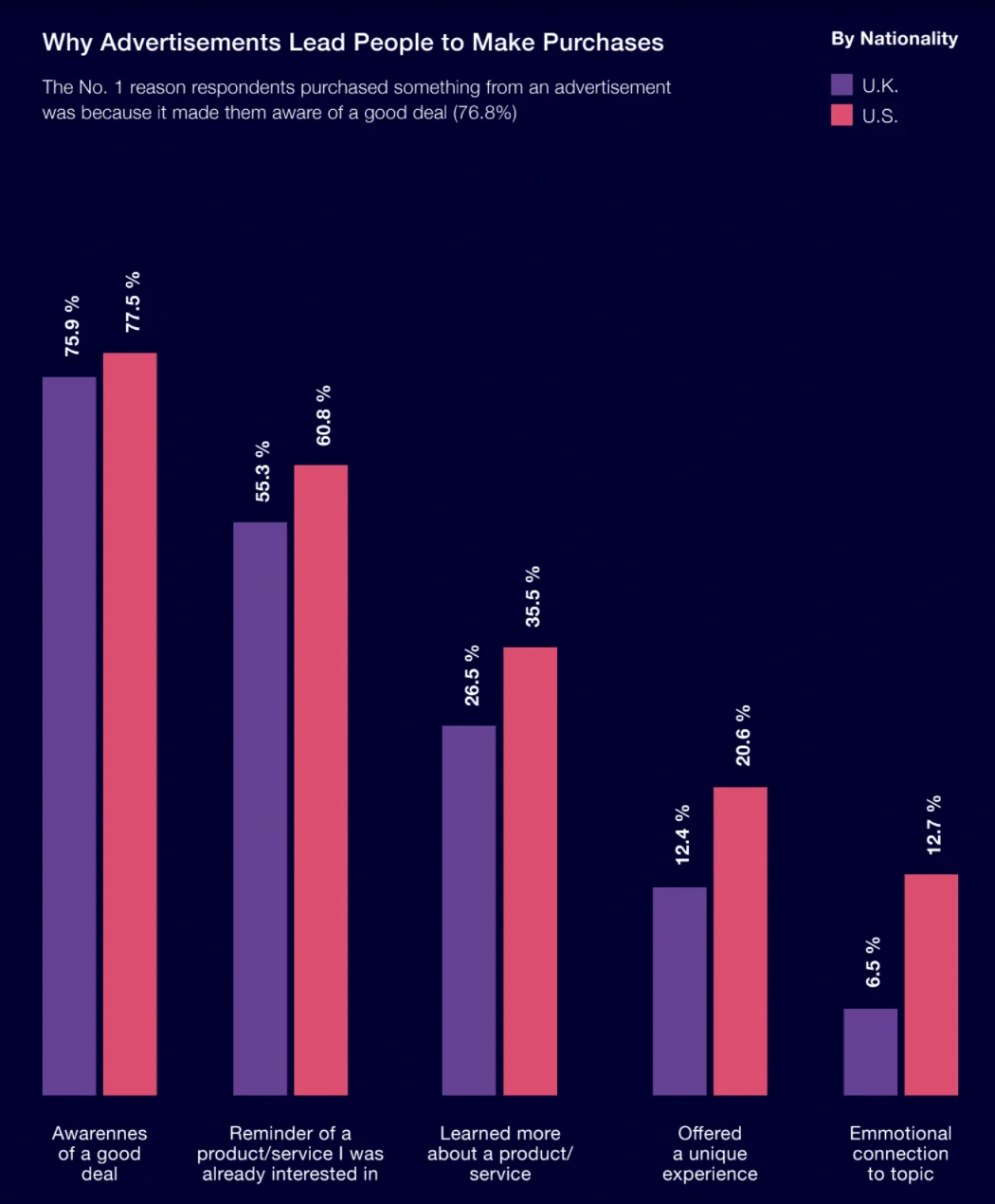
Reviewing Reviews
Our data confirm the centrality of reviews in the customer journey: More than two-thirds of respondents said they usually or regularly consulted online reviews before buying a product or service. Not all reviews are weighed equally, however, with certain characteristics viewed as essential markers of credibility and quality.
In both the U.K. and the U.S., approximately 6 in 10 individuals said the inclusion of both pros and cons was a key indicator of review quality. This perspective may reflect concerns about the prevalence of fake reviews on some platforms. Balanced reviews are more likely to be real than feedback that is effusively and exclusively positive. Similarly, images were important for 37 percent of U.K. residents and 45 percent of U.S. respondents. A picture might serve as another form of proof that a review is real – and that the delivered product resembles images presented by the brand.
Which kinds of sponsored content reviews did respondents find most believable? User- generated reviews proved most credible for U.K. and U.S. respondents alike, with ratings claiming a distant second place. This finding implies that real user reviews, when incorporated into a larger digital strategy, may be a powerful antidote to the advertising trust deficit discussed above. Indeed, the marketing industry is increasingly emphasising user-generated content as an essential dimension of brand activity online – particularly as consumers grow wary of more direct modes of advertising.
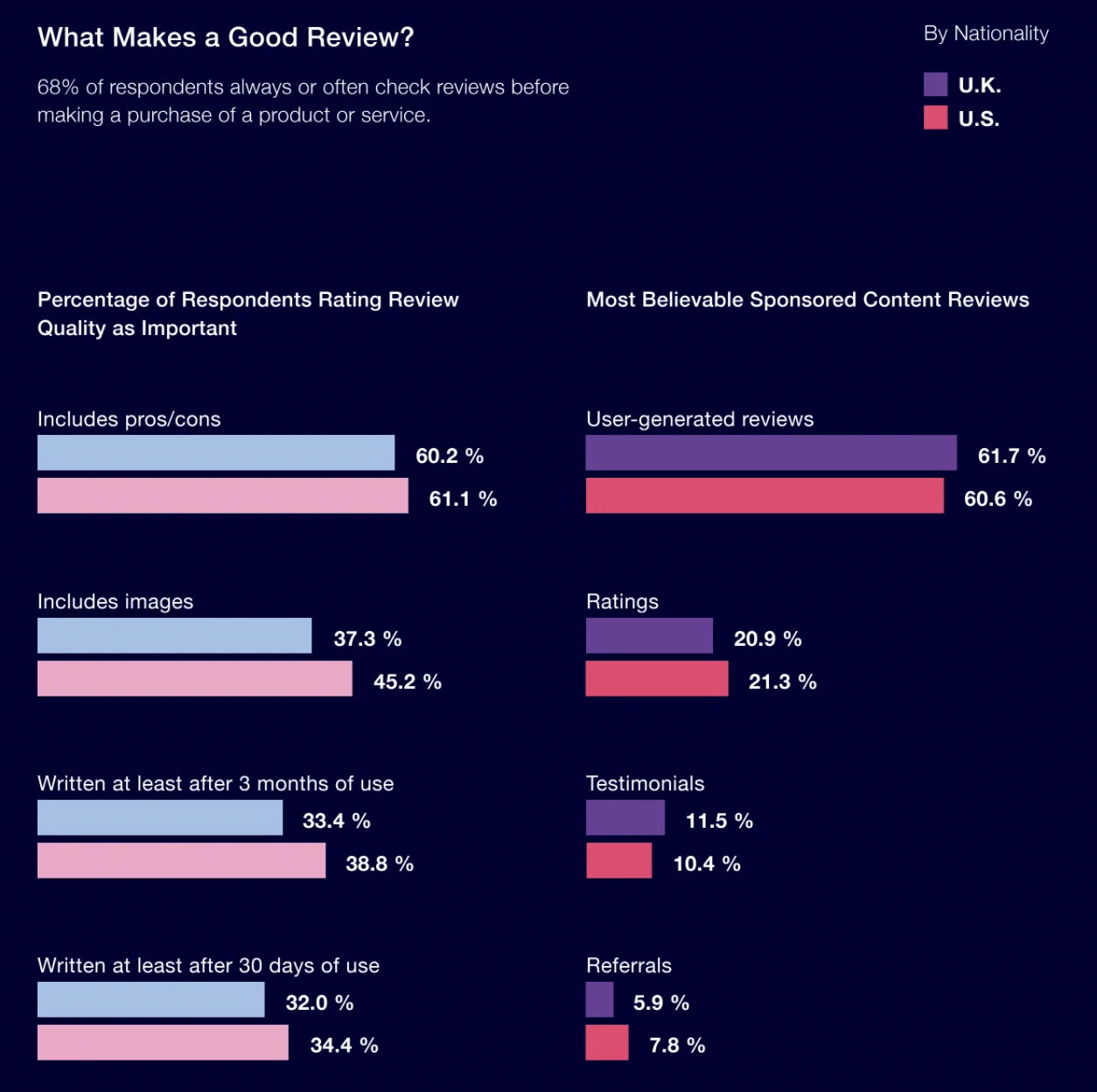
Authenticity: a principle for all platforms
While our findings vary somewhat by gender and geography, the prevailing themes are clear: Across various platforms, digital advertising is met with indifference or suspicion by most consumers. Conversely, most shoppers
proactively seek reviews before completing a purchase, prising real feedback from past customers.
Yet, no brand should renounce advertising entirely or focus exclusively on driving positive reviews. Rather, companies must utilise advertising channels in an authentic manner, echoing positive sentiments voiced by customers.
When brands can back their advertising claims with real testimonials, they can transcend the widespread skepticism evident in our findings. This approach is both holistic and transparent. Truthful brand messaging endures across channels, matching rhetoric and reality.
At Trustpilot, we’re leaders in helping companies integrate customer reviews into their broader digital strategies. By empowering customers to leave authentic feedback, our platform yields tremendous benefits for businesses large and small. From improved search performance to conversion optimisation, find out how your company can thrive by earning, request a free Trustpilot demo below.
Methodology
We collected responses from 2,048 consumers via a survey. U.S. respondents were collected using Amazon’s Mechanical Turk and U.K. respondents through Prolific. 49.6% of participants currently resided in the U.K., and 50.4% currently resided in the U.S. 86.4% of participants currently resided in England, 8.9% in Scotland, and 4.7% in Wales. 10.8% of participants resided in the East Midlands, and 7.1% in East of England. 42.6% of participants were men, and 57.4% were women.
Demographics with a sample size below 26 were excluded from the analysis; for this study, that included residents of Northern Ireland. Also, data presented in this study rely on self-reporting, which can introduce issues such as, but not limited to, selective memory and exaggeration. Statistical testing was not conducted in this study, and the research conducted was exploratory. Future research could explore reviews and purchasing behavior.
Fair Use Statement
Don’t worry, ad skeptics: We’re not buying or selling anything here. Still, we’d love to see the results of this survey shared with a wider audience. For that reason, this project’s information and images are yours to use for any noncommercial purpose. Please simply provide a link back to this page so that our team receives due credit for their work.
Sources
Marketingweek - Social spend accelerating despite most marketers not being able to prove impact
Marketingland - Native will dominate display spending in 2018
ReCode - Advertisers will spend $40 billion more on internet ads than on TV ads this year
AdWeek - New Study Highlights How Much People Dislike Digital Ads
Wallstreet Journal - Are Consumers ‘Adlergic’? A Look at Ad-Blocking Habits
The Simple Dollar - Effective Frequency: Why Ads Might Impact You More Than You Think
CNBC - One-quarter of Netflix subscribers may drop streaming video service if it runs ads
AdWeek - Why Every Brand Should Be Watching the Emerging Beauty Industry
The Guardian - Social media ad spend to overtake TV's in spite of Facebook woes
Ipsos - Advertising execs rank below politicians as Britain’s least-trusted profession
Forbes - How Brands Should Be Working To Fix The Consumer Trust Crisis
Forbes - Here's How Your Brand Can Make The Most Of User-Generated Content



